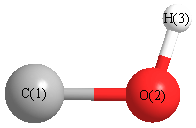Vibrational Frequencies calculated at MP2/CEP-31G
| Mode Number |
Symmetry |
Frequency
(cm-1) |
Scaled Frequency
(cm-1) |
IR Intensities
(km mol-1) |
Raman Act
(Å4/u) |
Dep P |
Dep U |
|---|
| 1 |
A' |
3501 |
3383 |
26.38 |
170.53 |
0.30 |
0.47 |
| 2 |
A' |
1216 |
1175 |
75.33 |
17.84 |
0.60 |
0.75 |
| 3 |
A' |
1081 |
1045 |
206.67 |
8.26 |
0.70 |
0.82 |
Unscaled Zero Point Vibrational Energy (zpe) 2899.0 cm
-1
Scaled (by 0.9663) Zero Point Vibrational Energy (zpe) 2801.3 cm
-1
See section
III.C.1 List or set vibrational scaling factors
to change the scale factors used here.
See section
III.C.2
Calculate a vibrational scaling factor for a given set of molecules
to determine the least squares best scaling factor.
